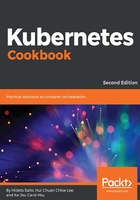
上QQ阅读APP看书,第一时间看更新
How it works...
minikube is suitable for setting up Kubernetes on your macOS with the following command, which downloads and starts a Kubernetes VM stet, and then configures the kubectl configuration (~/.kube/config):
//use --vm-driver=hyperkit to specify to use hyperkit
$ /usr/local/bin/minikube start --vm-driver=hyperkit
Starting local Kubernetes v1.10.0 cluster...
Starting VM...
Downloading Minikube ISO
150.53 MB / 150.53 MB [============================================] 100.00% 0s
Getting VM IP address...
Moving files into cluster...
Downloading kubeadm v1.10.0
Downloading kubelet v1.10.0
Finished Downloading kubelet v1.10.0
Finished Downloading kubeadm v1.10.0
Setting up certs...
Connecting to cluster...
Setting up kubeconfig...
Starting cluster components...
Kubectl is now configured to use the cluster.
Loading cached images from config file.
//check whether .kube/config is configured or not
$ cat ~/.kube/config
apiVersion: v1
clusters:
- cluster:
certificate-authority: /Users/saito/.minikube/ca.crt
server: https://192.168.64.26:8443
name: minikube
contexts:
- context:
cluster: minikube
user: minikube
name: minikube
current-context: minikube
kind: Config
preferences: {}
users:
- name: minikube
user:
as-user-extra: {}
client-certificate: /Users/saito/.minikube/client.crt
client-key: /Users/saito/.minikube/client.key
After getting all the necessary packages, perform the following steps:
- Wait for a few minutes for the Kubernetes cluster setup to complete.
- Use kubectl version to check the Kubernetes master version and kubectl get cs to see the component status.
- Also, use the kubectl get nodes command to check whether the Kubernetes node is ready or not:
//it shows kubectl (Client) is 1.10.1, and Kubernetes master (Server) is 1.10.0
$ /usr/local/bin/kubectl version --short
Client Version: v1.10.1
Server Version: v1.10.0
//get cs will shows Component Status
$ kubectl get cs
NAME STATUS MESSAGE ERROR
controller-manager Healthy ok
scheduler Healthy ok
etcd-0 Healthy {"health": "true"}
//Kubernetes node (minikube) is ready
$ /usr/local/bin/kubectl get nodes
NAME STATUS ROLES AGE VERSION
minikube Ready master 2m v1.10.0
- Now you can start to use Kubernetes on your machine. The following sections describe how to use the kubectl command to manipulate Docker containers.
- Note that, in some cases, you may need to maintain the Kubernetes cluster, such as starting/stopping the VM or completely deleting it. The following commands maintain the minikube environment:

For example, minikube starts a dashboard (the Kubernetes UI) by the default. If you want to access the dashboard, type minikube dashboard; it then opens your default browser and connects the Kubernetes UI, as illustrated in the following screenshot:
